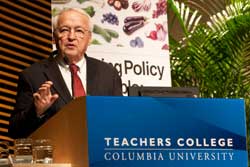Fighting the Good Fight, One Broccoli Spear at a Time
The USDA's Kevin Concannon is using federal food programs to nudge people toward healthier eating
“You are doing work that has never been more important in the life of our country, short of the Great Depression. More people are facing food insecurity for prolonged periods of time, even as rates of obesity have risen. These are two sides of the same coin, even though they are not often recognized as such.”
In remarks that closed the nutrition conference held at TC on Valentine’s Day, Kevin Concannon, Under Secretary for Food, Nutrition and Consumer Services in the U.S. Department of Agriculture, spoke with the air of a battle-weary officer welcoming fresh recruits to the front.
“This has been a very affirming morning,” he said. “I wish could clone some of these speakers and shop them around the country – including on Capitol Hill.”
Among his other duties, Concannon oversees SNAP (the Supplemental Nutrition Assistance Program, formerly known as Food Stamps), which serves some 47 million Americans; WIC (the Special Supplemental Nutrition Program for Women, Infants and Children), which serves 53 percent of all newborns during the first year of life; and the National School Lunch, School Breakfast, and Summer Food Service Programs. His role has given him a front-row perspective on how the nation’s economic crunch has affected those most in need.
“SNAP is intended to be supplemental but it may be the only strand of a very challenged safety net” for a growing number of Americans “who have no other source of support,” he said, adding that among people who depend on the program, the percentage of those with no net income has increased significantly during the past decade.
Given such heavy public reliance on SNAP and WIC, Concannon has sought to use the programs to “nudge people toward healthier eating.” His office is working to require bodegas and other smaller food stores, which comprise 18 percent of the 245,000 food stores nationwide that process SNAP benefits, to increase their “depth of stock” (fresh produce and other offerings). The USDA has replaced the previously ubiquitous “food pyramid” with “MyPlate,” a more user-friendly illustration of the five food groups that are the building blocks for a healthy diet. Since instituting requirements that have made school lunches healthier for the 30 million American students who depend on them, Concannon and his team have introduced legislation to improve “competitive food” – the vending machine snacks and other offerings that schools often provide in addition to what they serve in the cafeteria. And Concannon is working with the Department of Health and Human Services to recommend the first set of federal dietary guidelines for children from birth to 24 months.
It’s been an uphill fight, but there have been definite signs of progress – such as when Concannon, who regularly tours the country visiting school cafeteria, recently ate lunch with two young students.
“One of them said to me, ‘Mister, if you’re not gonna finish that broccoli, I’ll finish it for you,’” Concannon recounted. “I threw up my arms and said, ‘Victory is ours!”
Published Saturday, Feb. 23, 2013
